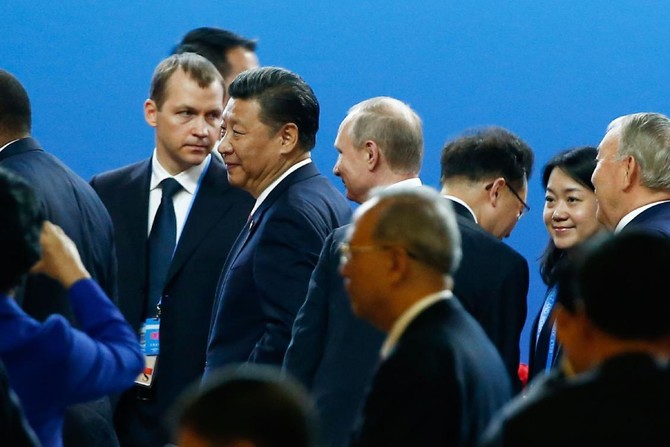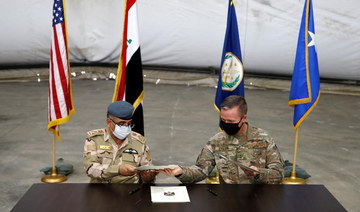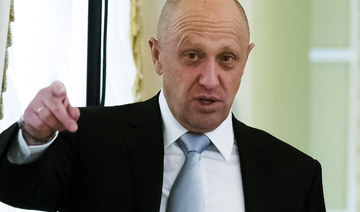BEIJING: China opened on Sunday a summit to promote an ambitious global trade infrastructure project highlighting its growing leadership on globalization, but a North Korean missile test threatened to overshadow the event.
President Xi Jinping was preparing to host leaders from 29 nations for the two-day summit in Beijing when US and South Korean military officials confirmed that Pyongyang had launched a ballistic missile.
Delegations from North Korea and the United States were expected at the forum, though not their leaders. Few Western heads of government made the trip.
The summit is showcasing Xi’s cherished One Belt, One Road initiative, a revival of the Silk Road that could cement China’s growing global clout on trade and geopolitics.
“This is indeed a gathering of great minds,” Xi said, addressing leaders including Russian President Vladimir Putin and Turkish counterpart Recep Tayyip Erdogan.
Xi, who pledged to pump an extra $124 billion in funds, hailed the initiative as “a project of the century” in a “world fraught with challenges.”
The Chinese-bankrolled project seeks to link the country with Africa, Asia and Europe through an enormous network of ports, railways, roads and industrial parks.
The initiative spans some 65 countries representing 60 percent of the world population and around a third of global gross domestic product. The China Development Bank has earmarked $890 billion for some 900 projects.
Xi did not address the North Korean missile launch in his speech, but Beijing has warned its communist ally in recent months to avoid any new missile or nuclear tests.
North Korea relies heavily on trade with China for its economic survival, and US President Donald Trump has urged Xi to use that leverage to put pressure on Pyongyang.
Sunday’s missile launch “is absolutely an embarrassment to Beijing but it also shouldn’t be overstated,” Christopher Balding, economics professor at Peking University, told AFP.
“This will not overshadow (the summit) in an enormous way but it will absolutely continue to raise US frustrations with Beijing,” he said, adding that Washington was “frustrated” that North Korea was also invited to the summit.
Xi focused on his initiative, boasting that it represented a “road for peace,” but he cautioned “all countries should respect each others’ sovereignty... and territorial integrity.”
Xi has defended globalization at a time when Trump has vowed to put “America First” in international trade and relations.
He warned that “isolation results in backwardness.”
Praising Xi’s initiative, Putin said the “risks of fragmentation of the global economic area are more and more obvious. Protectionism is becoming the norm.”
“The ideas of openness, trade freedom are rejected more and more, very often by those who were their supporters not so long ago,” Putin said.
For his part, Erdogan said Belt and Road was “going to be the kind of initiative that will put an end to terrorism.”
The project is seen as a practical solution to relieve China’s industrial overcapacity. But it could also serve Beijing’s geopolitical ambitions.
“In my view, Belt and Road is intended to create greater economic interdependence between China and its neighbors, which Beijing hopes will translate into increased political influence,” said Bonnie Glaser, director of the China Power Project at the Washington-based Center for Strategic and International Studies.
“Xi Jinping wants China to become the dominant regional power in an essentially Sino-centric order,” Glaser said.
Some Belt and Road projects are raising concerns in certain countries.
India has voiced displeasure at the China-Pakistan Economic Corridor, a Belt and Road project aimed at linking northwestern China to the Arabian Sea.
The route cuts through Gilgit and Baltistan in Pakistan-administered Kashmir, disputed territory that India claims is illegally occupied.
Human Rights Watch raised fears on Saturday about the treatment of people along the new Silk Road route in Central Asian nations with poor track records in infrastructure projects.
The US-based organization said Chinese authorities have “heightened surveillance and repression to prevent potential unrest that could impede” Belt and Road plans in the western Xinjiang region.
China hosts Silk Road summit in shadow of N.Korea missile
China hosts Silk Road summit in shadow of N.Korea missile

Afghans spend Eid in poverty after fleeing Pakistan

- Pakistan forcibly deported thousands of Afghans last year who were allegedly living in country without legal documents
- War-ravaged Afghanistan deals with refugees returning as it reels from humanitarian, climate and economic crises
MOYE MUBARAK, Afghanistan: Seven months since fleeing Pakistan out of fear of deportation, Jan Mohammad marked the Eid Al-Adha holiday on Monday struggling to feed his family, still living in a tent in Afghanistan in the border province of Nangarhar.
“We are spending Eid as if we were in prison,” the 30-year-old father of six told AFP.
“We have absolutely no money. We are still grateful to Allah that we are alive but sometimes we regret that as well. We can’t do anything. This year, and this Eid, we became fully bankrupt.”
He and his family crossed from Pakistan at the end of last year, not long after a deadline set by Islamabad for Afghans without legal right to stay in the country to leave.
Hundreds of thousands Afghans have hurriedly packed up their belongings to start fresh in their homeland, a place many of them had never seen before, in the months since the November 1, 2023 deadline.
But months later, many have still not found their feet.
Mohammad and his family were living in a tent encampment in the Moye Mubarak area of Nangarhar with other recently returned Afghan families.
He worked as a trainer at a sports club in Pakistan but is now jobless, unable to provide sufficient food for his family, let alone take part in Eid Al-Adha traditions of buying new clothes or a sheep for the ritual sacrifice or gathering with extended family and friends.
“My children don’t have proper food to eat or clothes to wear (for Eid), or shoes, while the children in the nearby villages have good clothes and shoes. My children want the same things. It is very difficult but we are helpless,” Mohammad said.
“It breaks my heart, I sit in a corner at home and cry.”
In a nearby tent, Sang Bibi is also holding on by a thread. Where other families were buying new clothes for Eid, she and her six children can rarely wash and beg for hand-me-downs to wear.
“We even beg for the clothes of dead,” the 60-year-old widow, the sole breadwinner for her family, told AFP.
“We have been in a terrible situation these past two Eids,” she said, referring to Eid Al-Fitr, which fell at the end of the holy month of Ramadan in April this year.
The influx of returnees into Afghanistan from both Pakistan and Iran came as the war-ravaged country grapples with economic, climate and humanitarian crises.
UN refugee agency UNHCR said last year that Afghans make up the third-largest group of displaced people globally, with around eight million Afghans living across 103 countries as of 2023.
The Taliban government, which took power almost three years ago, provided some support for the returnees, but struggled to cope with the surge.
“We want the government to help us by providing shelter,” said Sana Gul, who has lived in a tent with her husband and their two daughters since coming from Pakistan.
In the days ahead of Eid, markets were bustling with shoppers buying sweets and food for the holiday, with many families sharing meat with poorer relations during the holiday.
But having spent years, if not their whole lives, abroad, fleeing Afghanistan’s successive conflicts, many returnees have few networks to support them.
“We don’t even have bread to eat,” said Gul’s husband Safar.
Philippines says navy officer severely injured in China Coast Guard ‘ramming’

- Manila's national task force on the West Philippine Sea later said the Chinese vessels had "engaged in dangerous manoeuvres, including ramming and towing"
- This month, Manila accused Chinese boats of illegally seizing food and medicine airdropped to the Philippine outpost in the area
Manila: The Philippines said Tuesday one of its navy personnel was severely injured after the China Coast Guard rammed a Philippine vessel near Second Thomas Shoal in the South China Sea.
"A Philippine Navy personnel sustained severe injury after the CCG's (China Coast Guard's) intentional high-speed ramming during the rotation and resupply mission to the BRP Sierra Madre (LS57) on June 17," a military statement said.
The shoal, which hosts a tiny Philippine garrison stationed on a deliberately beached old warship, has been a focus of escalating confrontations between Chinese and Philippine ships in recent months as Beijing steps up efforts to push its claims to the disputed area.
Shortly after the incident, the Chinese coast guard reported that a Philippine resupply ship in the area had "ignored many solemn warnings from the Chinese side".
It "approached the... Chinese vessel in an unprofessional way, resulting in a collision", Beijing said, accusing the ship of having "illegally broken into the sea near Ren'ai Reef".
"The Chinese Coast Guard took control measures against the Philippine ship in accordance with the law," it added.
But the Philippine armed forces called China's version of events "misleading", decrying "the illegal presence and actions of Chinese vessels within the Philippines' exclusive economic zone".
Manila's national task force on the West Philippine Sea later said the Chinese vessels had "engaged in dangerous manoeuvres, including ramming and towing".
"Their actions put at risk the lives of our personnel and damaged our boats," it said.
In an update, the Philippine military on Tuesday made its first casualty report from the incident, adding that the injured navy personnel "has been safely evacuated and received prompt medical treatment".
It gave no details on the sailor's injury and also did not comment on news reports that a sailor had lost a finger and that Chinese personnel also boarded a Philippine vessel and seized several guns and inflatable boats.
The Second Thomas Shoal lies about 200 kilometres (120 miles) from the western Philippine island of Palawan and more than 1,000 kilometres from China's nearest major landmass, Hainan island.
Beijing claims almost the entirety of the South China Sea, brushing aside competing claims from several Southeast Asian nations including the Philippines and an international ruling that its stance has no legal basis.
It deploys coast guard and other boats to patrol the waters and has turned several reefs into militarised artificial islands.
It has in recent months stepped up moves against Philippine vessels in the area around Second Thomas Shoal.
This month, Manila accused Chinese boats of illegally seizing food and medicine airdropped to the Philippine outpost in the area.
It was the first time supplies had been seized, the military said.
Chinese personnel on the boats later dumped the items in the water, Philippine Navy spokesman for the West Philippine Sea Commodore Roy Vincent Trinidad said.
It was not clear if they belonged to the Chinese coast guard or navy, the military said.
China in response insisted the Sierra Madre was illegally grounded on the reef and urged the Philippines to "stop making trouble".
China accuses US of ‘malign intention’ to discredit its COVID-19 vaccines

- US military launched a clandestine program during the COVID-16 pandemic to discredit China’s Sinovac inoculation in the Philippines
MANILA: China’s embassy in the Philippines accused the US military of “hypocrisy, malign intention and double standards” in response to a report of secret US campaign to undermine confidence in a Chinese vaccines and other aid during the COVID-19 pandemic.
The remarks made by the spokesperson of the Chinese Embassy in Manila on Tuesday were in response to a Reuters investigative report that said the US military launched a clandestine program during the COVID pandemic to discredit China’s Sinovac inoculation in the Philippines.
The investigation found the US military aimed to sow doubt about the safety and efficacy of vaccines and other life-saving aid supplied by China. Through phony Internet accounts meant to impersonate Filipinos, the military’s propaganda efforts morphed into an anti-vax campaign, according to the report.
“People around the world are indignant about the US military’s actions which lay bare the hypocrisy, malign intention and double standards of the United States,” an embassy spokesperson said in a statement.
“While talking about respecting human rights, the United States does just the opposite regarding the fundamental human rights of life and health of the Filipino people.”
The US Embassy in Manila referred a request for comment to its Department of Defense.
In the Reuters report, a senior Defense Department official acknowledged the US military engaged in secret propaganda to disparage China’s vaccine in the developing world, but the official declined to provide details.
A Pentagon spokeswoman was cited in the report as saying the US military “uses a variety of platforms, including social media, to counter those malign influence attacks aimed at the US, allies, and partners.” She also said China had started a “disinformation campaign to falsely blame the United States for the spread of COVID-19.”
Half a million immigrants could eventually get US citizenship under new plan from Biden

- About 50,000 noncitizen children with a parent who is married to a US citizen could also potentially qualify for the same process
- The president will also announce new regulations that will allow certain DACA beneficiaries and other young immigrants to more easily qualify for long-established work visas
WASHINGTON: President Joe Biden is taking an expansive, election-year step to offer relief to potentially hundreds of thousands of immigrants without legal status in the US — aiming to balance his own aggressive crackdown on the border earlier this month that enraged advocates and many Democratic lawmakers.
The White House announced Tuesday that the Biden administration will, in the coming months, allow certain spouses of US citizens without legal status to apply for permanent residency and eventually, citizenship. The move could affect upwards of half a million immigrants, according to senior administration officials.
To qualify, an immigrant must have lived in the United States for 10 years as of Monday and be married to a US citizen. If a qualifying immigrant’s application is approved, he or she would have three years to apply for a green card, and receive a temporary work permit and be shielded from deportation in the meantime.
About 50,000 noncitizen children with a parent who is married to a US citizen could also potentially qualify for the same process, according to senior administration officials who briefed reporters on the proposal on condition of anonymity. There is no requirement on how long the couple must have been married, and no one becomes eligible after Monday. That means immigrants who reach that 10 year mark any time after June 17, 2024, will not qualify for the program, according to the officials.
Senior administration officials said they anticipate the process will be open for applications by the end of the summer, and fees to apply have yet to be determined.
Biden will speak about his plans at a Tuesday afternoon event at the White House, which will also mark the 12th anniversary of the Deferred Action for Childhood Arrivals program, a popular Obama-era directive that offered deportation protections and temporary work permits for young immigrants who lack legal status.
White House officials privately encouraged Democrats in the House, which is in recess this week, to travel back to Washington to attend the announcement.
The president will also announce new regulations that will allow certain DACA beneficiaries and other young immigrants to more easily qualify for long-established work visas. That would allow qualifying immigrants to have protection that is sturdier than the work permits offered by DACA, which is currently facing legal challenges and is no longer taking new applications.
The power that Biden is invoking with his Tuesday announcement for spouses is not a novel one. The policy would expand on authority used by presidents George W. Bush and Barack Obama to allow “parole in place” for family members of military members, said Andrea Flores, a former policy adviser in the Obama and Biden administrations who is now a vice president at FWD.us, an immigration advocacy organization.
The parole-in-place process allows qualifying immigrants to get on the path to US permanent residency without leaving the country, removing a common barrier for those without legal status but married to Americans. Flores said it “fulfills President Biden’s day one promise to protect undocumented immigrants and their American families.”
Tuesday’s announcement comes two weeks after Biden unveiled a sweeping crackdown at the US-Mexico border that effectively halted asylum claims for those arriving between officially designated ports of entry. Immigrant-rights groups have sued the Biden administration over that directive, which a senior administration official said Monday had led to fewer border encounters between ports.
Drone attack sets oil tanks ablaze in southern Russia

- Ukraine did not immediately claim responsibility but it has carried out similar attacks on Russian energy facilities before
- Some 200 firefighters and emergency personnel were deployed to deal with the blaze
Kyiv, Ukraine: An overnight drone attack set several oil storage tanks ablaze near the town of Azov in southern Russia on Tuesday, sparking a large fire, local officials said.
Ukraine did not immediately claim responsibility but it has carried out similar attacks on Russian energy facilities before, arguing they are fair targets given that they fuel Moscow’s military.
“Oil product tanks caught fire in Azov as a result of a drone attack. According to preliminary data, there were no casualties,” the governor of the local Rostov region, Vasily Golubev, said on Telegram.
Video published by the emergencies ministry showed thick smoke and flames billowing out of what appeared to be multiple oil storage tanks in an undisclosed location.
Officials did not say how many drones were involved in the attack.
Some 200 firefighters and emergency personnel were deployed to deal with the blaze, which spanned an area of at least 3,200 square meters (3,800 square yards), the emergencies ministry said.
The Rostov region sits directly across the border from Ukrainian and is home to the operational headquarters overseeing Russia’s invasion.
On the battlefield, Ukraine said that Russian forces were fighting to enter the outskirts of Chasiv Yar, a flashpoint town of the war in the east whose capture could accelerate Russian advances.
Ukraine’s eastern region of Donetsk, where war-scarred Chasiv Yar lies, has borne the brunt of fighting over more than two years and the Kremlin claims the region is part of Russia.
“The enemy keeps trying to advance to the microdistrict Novy in the town of Chasiv Yar,” Ukraine’s military said in a briefing, adding that fighting was “currently taking place.”
Further south, it said Moscow’s forces were also pushing toward Pokrovsk, where they were closing in on a key road that would complicate supplies between strategic hubs in the region.
Ukraine’s air force meanwhile said it had downed 10 Iranian-designed attack drones launched by Russian forces overnight.

















